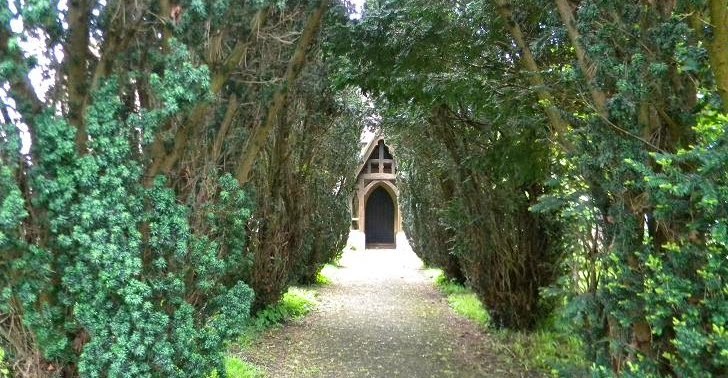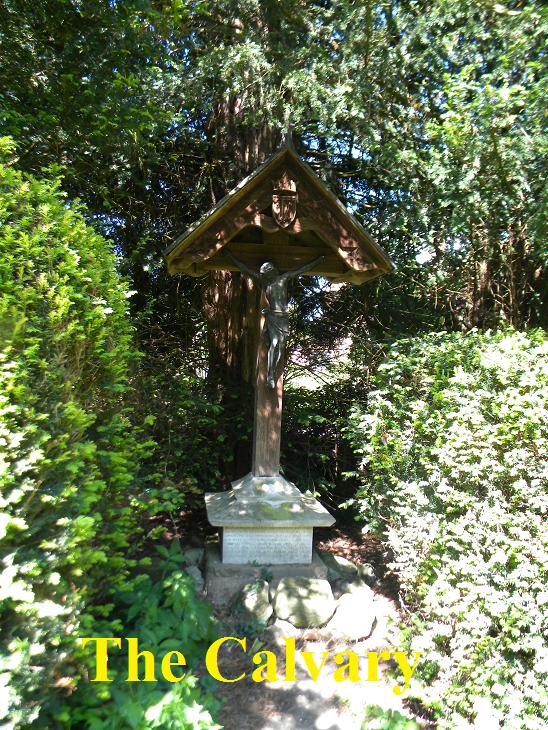Even though it was a long time ago my boyhood impression of St James, Huddington, was that it was a dark, dusty and generally untidy place. And I’m pleased to say that not a lot has changed in half a century. The gloom is not due to the lack of windows but because the small church is hemmed in, especially to the east and west, by tall yew trees that even on the brightest of days prevent the sun’s light from directly entering.
The north doorway (and wall with lancet window) is Norman. An upper door arch was added in the 15th century but it is in keeping with the original. That sums up this little church. Much of the building has been restored over the centuries but all the work has been done sensitively and in harmony with earlier construction. Even the 16th century roof (which would have replaced an earlier thatched roof) makes use of four ancient tie beams from the original structure. The one big disappointment is that the medieval priests’ door in the south chancel wall, sealed up with stone after the Reformation, remains closed. When the “modern” restoration was completed in 1900 they missed a trick there!
What more is there to see? There’s clear evidence of Puritan vandalism to image niches either side of the east window and a piscina on the south wall of the chancel. There is some fine wooden paneling and Jacobean furniture – notable a communion table with turned legs that now serves as the altar. And my pew. Did I mention my pew just inside the plain and simple 17th century chancel screen? It’s where I would sit when my father took the service from his stall opposite, or from the altar. Out of sight and harm’s way. I’m willing to bet that few people have sat there since!
My three gems in and around St James’ Huddington? First the font which is plain and simple and of early 15th century origin. But its base is made of a different stone and suggests that it once supported an earlier Norman (possibly) font. The rim of this font has been damaged – evidence that the locking clamps had been forcibly removed. A reminder of different ways in different days. Baptismal water would be left in the font for a season, and practitioners of witchcraft would steal it for their own purposes!
Second the heraldic glass in a window on the west wall of the side chapel. On the upper left the Coat of Arms of Roger and Elizabeth Wintour. Lower left are the Arms of the Casey family united with the Cooksey family. (I had to look up the correct term for this and it is impaling!) And in the right window the Wintour family impaling six families into which they married. The date is 1584.
And thirdly we must step outside the church and pause before a Calvary near the lychgate. This is a recent monument (early 20th century) and marks the spot where an unknown man was found buried. It is generally agreed that he was a Royalist fleeing the 1651 Battle of Worcester where the King’s army was routed by the Parliamentarians. Given that most of the royal army was Scottish, and that the man was found with a purse of Scottish coins, this theory makes a great deal of sense. It is also a moment to pause awhile and reflect on a man dying so far from home.
A mystery with which to close. In the paneling on the south wall of the chancel, in line with the altar, there is a closet which has not been locked in recent years. (I know – I check this on every visit.) It’s clearly an ambry cut into the stone. Inside are four pieces of stone, an empty glass bottle, and a cruet which appears to contain old wine. Undisturbed and unexplained. One of these days I will write to the local clergy…









Truly fascinating! I live but 5 miles from here and didn’t even know St James or even Huddington Court existed! Can anyone visit the church or, indeed, the Court? Thank you for sharing this.
LikeLike
Hi Gary. The home is privately owned and closed to visitors, but when I visited the place a few years ago, I was able to take photographs of the building and grounds and to enter the church, where there are bronzes commemorating members of the the Wintour family. It is well worth a visit!
LikeLike